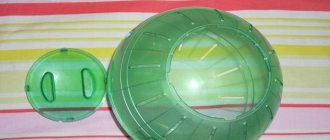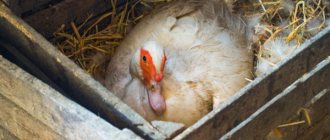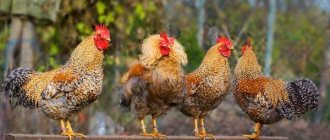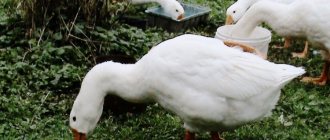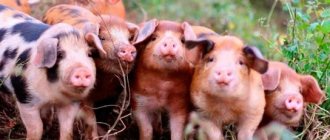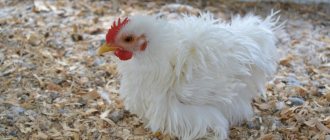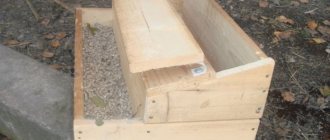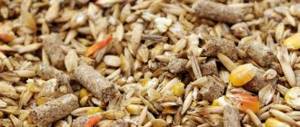231
no comments yet
1
Author:
Rasskazov Pavel.
Reading time: 5 minutes
In order for geese to grow quickly and gain weight, to be healthy and active, they need to be fed well. At the same time, not only food is important for the health of birds, but also the container where they get it from. Therefore, let’s figure out what types of feeders for geese there are, what their advantages and disadvantages are – and how to make a feeder with your own hands.
Types of structures
First, briefly about the different types of feeder designs.
Open – for dry and wet food
This is the simplest option, which is simply a shallow container open at the top into which food for the geese is poured or placed.
Its advantage:
- Simplicity. It's easy to make yourself by simply taking a small plastic bowl and filling it with food. It is even better to use a basin to feed a large number of adult birds.
- Ease of processing. All types of feeders require care - they must be cleaned and washed regularly. The easiest way to care for an open feeder is to shake out the remaining food, spray it with a hose – that’s it, it’s ready for a new filling.
However, there are also disadvantages:
- Each adult bird needs at least 20 cm of free feeder space. So if you have a large population, then the feeders will be large.
- From open feeders, geese constantly scatter food across the floor of the poultry house , and if the container is large, they can climb into it with their feet.
With windows
This is a type of open feeder. It differs in that the container is equipped with a lid on top, where holes are made through which geese can stick their heads and eat - but cannot crawl through entirely. Another design option is a feeder, covered on top with a grid with cells of sufficient size to give the geese access to food.
Advantages:
- Simplicity. The simplest option is a structure of two boards, knocked together to form a right angle. Triangular or square caps are attached to the structure at the ends, and limiting slats are placed between the boards.
- Scalability. This feeder is easy to make for both adult birds and young birds. Only the sizes will change.
- Ease of use. There is no need to worry about the birds scattering too much food.
But there are also disadvantages:
- The simplest wooden feeders of this type are only suitable for dry food. To use wet food, other materials are needed - and the design becomes more difficult to manufacture.
Bunker
A bunker feeder solves the problem of food spreading even better. Its design includes two main elements:
- Closed bunker in which feed is placed - grain mixture, soaked feed, etc.
- Actually the feeder.
Expert opinion
Novoselova Sofya Ivanovna
Farmer. 20 years of experience.
Ask a Question
The principle of operation is based on the fact that the feed is gradually poured from the hopper into the feeder under the influence of gravity. This happens as the geese eat food - and therefore such designs are convenient precisely because they only need to be refueled once or twice a day, and the feeding time for birds is not limited.
Advantages of this type of feeder:
- Autonomy. It is enough to fill the feeder once and it will provide the geese with food for a long time.
- Complete closure. The bulk of the food is out of reach of the birds.
- Customizability. Almost always, the feeder can be adjusted to reduce or increase the rate at which bird food arrives.
The only drawback can be considered the complexity of the design.
Automatic
Automatic feeders are designed to provide birds with portions of food without human assistance. The simplest option is a bunker device, however, there are more complex designs that include the following:
- Reception bunker.
- Feed distribution pipes.
- Individual feeders.
- Gearmotor.
- Fastening and suspension system.
Typically, such feeders are used on large farms for hundreds and thousands of birds. Advantages of automatic lines:
- autonomy;
- productivity - any quantity of poultry can be provided with feed, as long as the capacity of the bunker is sufficient.
The main disadvantages are the high cost and complexity of the design.
Trough drinker for adult ducks
It is best to make a drinking bowl for ducks and any other birds from materials that are resistant to rotting and quite durable.
In this sense, a large-diameter plastic pipe is perfect:
The instructions for its manufacture are obvious - you need to cut several identical holes (for ducklings - small, for adult ducks - 3-4 times larger in all dimensions) and install it on a pre-designed durable stand. One end of the pipe is screwed with a plug, and an angle is installed on the other, through which water is poured.
The simplest drinking bowl for ducks is a sewer pipe with holes.
The only drawback of such a device is that, together with water, it is quite heavy, and ducks will caress their beaks quite often, so the water will also have to be changed often. You will need the help of a second person to pull out the pipe, holding it on both sides.
Which feeders are the most convenient in design?
When talking about convenience, you need to consider the following:
- The simpler the design, the more convenient it is to care for. An ordinary open container is easy to wash and clean, but it’s difficult to even start an automatic feeding line without having some engineering skills;
- The longer the feeder operates without a person, the less effort is spent on feeding the birds. Therefore, bunker feeders are more convenient than open feeders: once placed the feed can be enough for a whole day, and if the feed does not spoil, and the livestock is small, then even for one and a half to two days.
In descending order according to the totality of characteristics, you can arrange the feeders according to convenience:
- Bunkers.
- Feeder with windows.
- Open feeder.
- Automatic. Despite their effectiveness, they are in demand only for poultry farms.
Making our own
Today we will talk about how to make a classic wooden feeder for adult birds with your own hands. It is quite convenient both for cleaning and for filling with food by the owner. If you follow all the recommendations for designing the structure, the birds will behave extremely carefully during the meal.
Tools and materials
To make a feeder with your own hands we will need:
- sheets of wood or chipboard, about two centimeters thick;
- tools for fastening parts;
- fastening equipment - drill, hammer.
Instructions
It’s easy to make a feeder with your own hands, following the instructions:
- Create a sketch or drawing of a feeder. It should be a container with a fairly high front wall. This will prevent birds from getting inside and trampling the food.
- Cut sheets of wood into the desired shape.
- Secure the sheets together using a hammer or drill. Make sure the structure is as tight as possible.
- Provide some sort of lid for the feeder. The gap between the front wall and the lid should not be less than 15 centimeters.
Material requirements
Geese are waterfowl. Not only do they drink a lot and tolerate hunger more easily than thirst, but they also prefer to eat food with some water. Therefore, all poultry farmers try to feed them with wet mixtures.
Feeders for wet food
For this type of feed, the following qualities of the feeder are required:
- Tightness. It shouldn't leak.
- No corrosion or deformation due to moisture.
Metal primarily meets these requirements. It is best to use galvanized steel or another type of metal for feeders that will not rust when in contact with water.
It should be taken into account that when fattening birds, especially young animals, mixtures containing milk or whey are widely used. Metal is absolutely not suitable for such feeds: dairy products are more chemically active than water, and steel can begin to deteriorate. Here it is best to use different types of plastic.
Feeders for dry food and mineral supplements
It is much easier with dry grain mixtures and minerals (crushed chalk, sand, crushed shells, etc.). There are practically no requirements for material here, so for dry food you can use wooden feeders of any design - from a box covered on top with a grid of slats to a full-fledged bunker.
What diseases are geese susceptible to? Symptoms and methods of treatment of infectious, non-contagious and parasitic diseases
Read
The best varieties of white geese. Features, egg production, weight indicators
More details
The best breeds of geese for home breeding. TOP meat, egg and ornamental birds
Look
TOP 5 breeds of geese with a large build. Features, productivity indicators
Further
How to make a goose feeder with your own hands
The bunker device consists of a compartment where the feed is stored and an outlet for its dosed supply. To assemble it correctly, you must follow a certain sequence of actions:
- Mark the plastic container in accordance with the diameter of the sewer pipe used. The mark should be 30-40 cm from the bottom of the container, otherwise it will be inconvenient for the geese to eat food from such a height.
- Prepare fragments of the sewer pipe and cut them along the corner of the elbow.
- Cut an opening in a plastic container according to the diameter of the pipe. Install it into the resulting hole.
- Using hot melt glue, process the edges of the pipe. This simple technique will allow it not to turn while feeding the bird. Hot-melt adhesive will also eliminate the possibility of moisture penetrating inside the container with dry food.
If desired, you can increase the level of moisture protection of the feed. To do this, you will need to install a canopy made of metal or plastic. The optimal distance from the edge of the pipe to the canopy is 10 cm. All that remains is to pour the nutritional composition for the growth and development of poultry into the finished feeder.
You can make the necessary equipment for geese from a 5 liter plastic bottle. A circle of small diameter is cut out in the bottom of the container into which the food will be poured, and holes for ropes are made along the edges with a hot nail. The bottle is turned upside down, hung, and a basin is placed under it. This simple design greatly simplifies the process of feeding geese.
The herbal device is made of wood, which is absolutely safe for animals. For green fodder it is not necessary to use a trough. This can be a regular device made of slats, but it is recommended to clean them so that there are no burrs.
It is very simple to make a device for feeding poultry with your own hands. When choosing suitable equipment, first of all, you should take into account the number of geese on the farm and the type of food. The main thing is that in order not to expose the livestock to the risk of getting sick, both feeders and drinking bowls should always be kept clean and periodically disinfected.
Size
For the goslings
When choosing or making a feeder for goslings, you need to proceed from the following:
- height - depending on age, but no more than 2-3 cm above the back of the chick. The optimal option is from 5 to 10 cm;
- volume – also depending on age, but not less than 5-10 cubic meters. cm for each gosling.
For adult birds
The following sizes of feeders are suitable for adult geese:
- height – up to 15-20 cm;
- volume – at least 15 cubic meters. cm for each bird.
